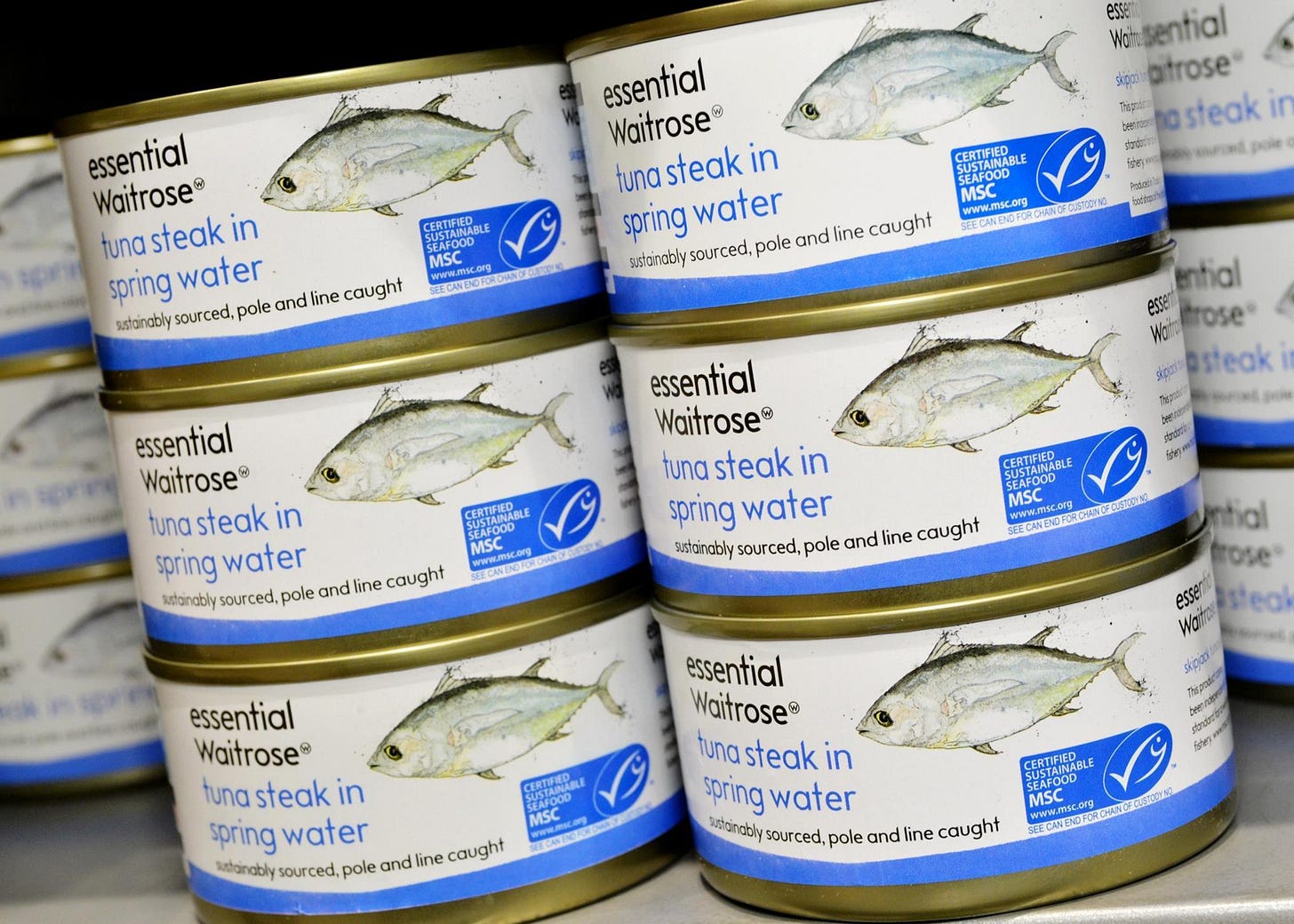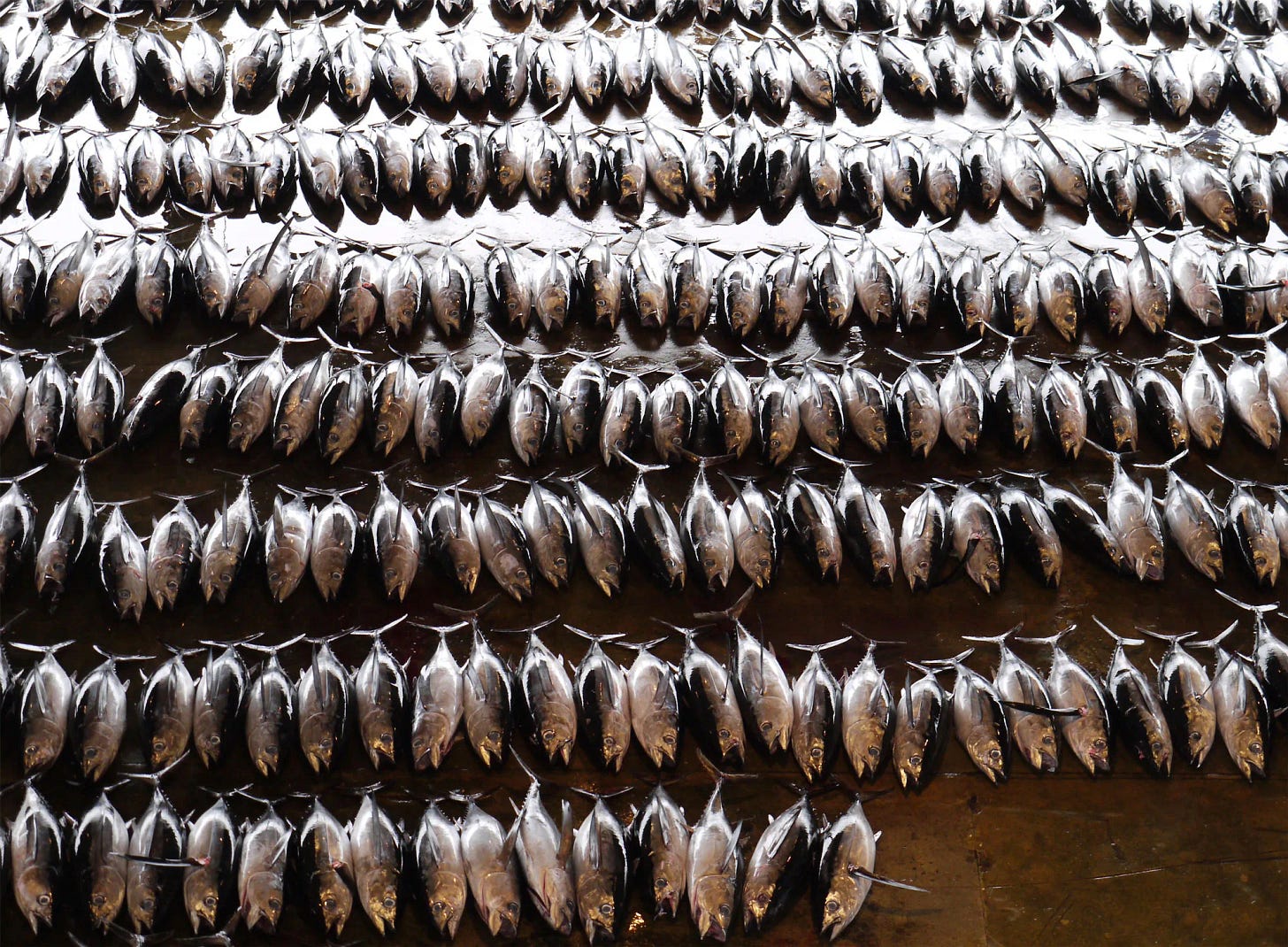THIS is sustainable industrial fishing
Inside this billion-dollar myth and what it’s costing the planet.
They’re selling you extinction with a “sustainable” label.
The UN's latest Ocean Conference closed with the same tired promise: “Support sustainable fisheries.”
But behind the polished speeches and blue branding lies a brutal truth.
Industrial fishing cannot be sustainable.
It never was. It never will be.
The sustainability myth: How industrial fishing became untouchable
We are told that certain fisheries are “certified sustainable.”
We’re shown clean packaging and labels from third-party organizations.
We’re reassured that our choices are saving the ocean.
But behind those logos are fleets that:
Drag bottom trawl nets across coral reefs thousands of years old.
Kill up to 50% of what they catch as “bycatch” (non-target species).
Contribute to more ocean plastic pollution than all the world’s straws, bags, and bottles combined.
Use forced labor and slavery to keep costs down and profits up.
The Marine Stewardship Council (MSC)—perhaps the most recognizable certification—has stamped “sustainable” on fisheries known to kill endangered species, destroy seabed habitats, and operate in illegal or opaque ways.
Even fisheries that collapse years later still carry the logo until the very end.
Because it’s not about science.
It’s about perception.
Destruction doesn’t become sustainable just because you stamp a logo on it.
The food security lie
World leaders love to say we need fishing to feed the world. That we can’t stop industrial fishing because billions rely on it. That we need to fish more to feed the hungry.
This is emotional blackmail, and it's scientifically false.
Here’s the reality:
1/3 of the world’s wild-caught fish are used for animal feed, not human food.
About 70% of fishmeal and 73% of fish oil produced globally is used in aquaculture, not for human consumption.
Poorer coastal nations like Senegal, Ghana, and the Philippines are seeing their waters emptied and their ecosystem destroyed to supply pet food, cosmetics, and livestock feed in Europe and China.
In other words:
We are starving humans to feed fish to richer humans’ fish.
And farmed fish is no answer.
A single farmed salmon can consume 4-5kg of wild fish before it reaches your plate.
This is called the “fish-in, fish-out” problem—and it means fish farming is a net loss for global food security.
And yet we keep calling this “sustainable.”
The planetary cost
Industrial fishing doesn’t just kill fish. It kills the planet.
Bottom trawling releases more carbon annually than all global air travel by disturbing deep carbon stores.
Fishing fleets use millions of liters of diesel every day, heavily subsidized by taxpayers.
Over 640,000 tonnes of fishing gear is lost or discarded into the sea every year, making fishing gear the #1 source of plastic pollution in the ocean by weight.
The fishing industry is the biggest killer of marine megafauna like dolphins, whales, turtles, and sharks.
And then there’s the biodiversity collapse.
Over 90% of global fish populations are fully exploited or overfished.
Entire species are disappearing.
When large fish like tuna, cod, or swordfish vanish, so do the complex ecosystems that depend on them.
We are breaking the ocean's food web one trawler, one “certified” net at a time.
The death of oversight
So where are the regulators?
Where are the watchdogs?
The truth is, they’ve been captured or silenced.
Certification bodies like the MSC receive royalties for every product that bears their logo.
The more they certify, the more they earn.
It’s a classic case of the fox guarding the henhouse, except it’s the ocean.
Meanwhile:
Global fisheries subsidies total over $35 billion per year, much of it fueling overfishing.
The European Union sends massive factory ships to West African waters, displacing whole communities.
Enforcement is nearly impossible on the high seas, where flags of convenience allow vessels to operate with near-total impunity.
This isn’t oversight.
This is an organized system of sanctioned plunder draped in the language of sustainability.
The math doesn’t lie — but the marketing does
They’ll tell you that fish farming is a “sustainable” solution.
But they won’t tell you that farming a single salmon, for instance, can require up to five wild fish ground into pellets.
For every 1 kg of farmed fish on your plate, multiple kilograms of wild fish are vanishing from the sea, often species no one ever intended to eat.
This is the “sustainable” loop:
Wild fish caught in massive nets
Turned into fishmeal
Fed to farmed fish
Labeled “eco-friendly” and sold at a premium
Meanwhile, coastal communities in West Africa and Southeast Asia are left with destroyed ecosystems.
The impossible promise: Feeding 8 billion people with fish
Politicians say the ocean is our answer to global hunger.
They don’t mention the reality:
Over 90% of global fish populations are fully exploited or overfished.
Industrial fleets are going deeper, further, and more destructively to chase fewer fish.
The climate crisis is pushing ocean species to the brink, disrupting food webs and spawning grounds.
You can’t feed 8 billion people with a resource that’s vanishing.
You can’t sustain an industry that requires destruction to survive.
What’s really being sustained?
Not biodiversity.
Not food security.
Not ocean health.
What’s being sustained is profit.
What’s being sustained is political convenience.
What’s being sustained is the illusion that business-as-usual is safe.
They’ll keep repeating “sustainable fishing” like a mantra, because the alternative, telling the truth, would mean real change.
And change threatens the billion-dollar interests fueling this lie.
Let this sink in:
Entire species have collapsed under “sustainable” watchlists.
The fishing industry is the #1 contributor to ocean plastic by weight.
Bottom trawling emits more CO₂ annually than air travel.
Millions of fish are thrown away every day. Dead, unused, unrecorded.
But none of that makes it into the sustainability reports.
None of that fits into the carefully curated blue branding.
This is what happens when…
We treat the ocean like a supermarket instead of a living system
Profit is prioritized over planetary boundaries
We redefine destruction as a solution
This is the story we’re not supposed to tell.
That there is no such thing as sustainable industrial fishing.
That real sustainability starts where industrial exploitation ends.
The ocean can heal if we let it.
But first, we have to stop calling harm a solution.
What real ocean protection looks like
It doesn’t look like another label, another subsidy or another UN panel saying, “We can fish better.”
It looks like this:
Actual protected areas. Protected from all fishing, mining, and extraction.
Regenerating coastal ecosystems, like mangroves and seagrasses, that absorb carbon and protect fish populations.
Banning bottom trawling and destructive gear.
Ending harmful subsidies that keep destructive fleets afloat.
Shifting to plant-based diets to relieve pressure on marine systems.
Enforcing corporate accountability, not just certification.
The ocean doesn’t need “better branding.”
It needs a break.
What you can do
Speak up: Challenge the “sustainable seafood” myth whenever you hear it.
Reduce or eliminate fish from your diet: It’s one of the most effective actions for marine protection.
Support local activists: From the Philippines to Ghana to Norway, people are fighting to protect the ocean. Back them.
Push for policy: Demand an end to subsidies and a global ban on bottom trawling.
Educate others: Share this Sea Story. Turn awareness into resistance.
Stand with the ocean. Before the silence becomes permanent.












Devastating